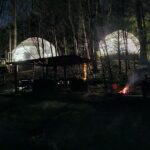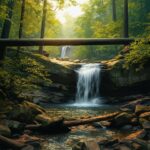
Welcome to the majestic landscapes of North Carolina! Nestled within the Blue Ridge Mountains, the charming towns of Brevard, Rosman, Hendersonville, and Asheville serve as gateways to an array of stunning natural wonders. From verdant forests to scenic waterfalls, our region brims with unique hiking trails suitable for the whole family. Whether you’re a seasoned adventurer seeking the thrill of new paths or a family looking to immerse in nature, we’ve got you covered. In this guide, we’ll journey through some of the most family-friendly hiking trails around these areas, highlighting their distinctive features and the unforgettable outdoor adventures they offer. So grab your hiking boots, and let’s dive in!
Here are some of the best family-friendly hiking trails around Brevard, Rosman, Hendersonville, and Asheville, NC:

- Pisgah National Forest TL;DR
- Trailhead address: Pisgah Ranger District, 1600 Pisgah Hwy, Pisgah Forest, NC 28768
- Distance from Brevard: Approx. 4 miles
- Highlights: This expansive national forest offers numerous family-friendly trails with varied difficulty levels. You can enjoy scenic waterfalls, majestic mountains, and the diverse flora and fauna of the area.
Pisgah National Forest is an enchanting natural oasis located in the Appalachian Mountains of western North Carolina. Here’s everything you need to know about this beautiful haven.
History: Established in 1916, Pisgah National Forest was one of the first national forests in the eastern United States. The forest was formed from a portion of the Biltmore Estate, the grand estate of George Washington Vanderbilt, which was sold to the federal government by his widow, Edith Vanderbilt. The Cradle of Forestry, located within the forest, is recognized as the birthplace of forest conservation in America.
Size: The forest stretches over approximately 512,000 acres, spread across several counties in western North Carolina, making it an extensive playground for nature lovers.
Attractions & Activities: Pisgah National Forest is a treasure trove of natural attractions and outdoor activities.
- Looking Glass Rock: An iconic geological structure, this pluton monolith provides an exciting and challenging hike for visitors, and the views from the top are simply breathtaking.
- Sliding Rock: This naturally occurring 60-foot waterslide, culminating in a 7-foot deep pool, is a favorite among both locals and visitors, especially in the warmer months.
- Cradle of Forestry: A historical site within the forest that serves as a testament to the area’s logging history and forest conservation movement. It offers trails, exhibits, and film presentations.
- Mount Pisgah: Named after the biblical mountain from which Moses saw the promised land, Mount Pisgah offers panoramic views of the surrounding scenery.
- Blue Ridge Parkway: Often referred to as “America’s Favorite Drive,” this scenic highway runs through the forest and provides spectacular views, hiking trails, and picnic spots.
- Waterfalls: The forest is home to several stunning waterfalls, including Looking Glass Falls, Daniel Ridge Falls, and Moore Cove Falls, which are all easily accessible.
Activities include hiking, mountain biking, camping, fishing, wildlife viewing, and rock climbing. During the winter months, some areas of the forest offer snow sports like skiing and snowshoeing.
The forest is also known for its remarkable biodiversity. It is home to numerous species of plants and animals, some of which are rare and endangered. This diverse habitat makes Pisgah National Forest a fantastic location for bird watching and nature photography.

- Dupont State Forest TL;DR
- Trailhead address: 1300 Staton Road, Cedar Mountain, NC 28718
- Distance from Brevard: Approx. 12 miles
- Highlights: Home to several incredible waterfalls including Triple Falls and High Falls. Trails here are well-maintained and provide a variety of options for all ages and skill levels.
DuPont State Recreational Forest, also known as DuPont Forest, is a remarkable natural treasure nestled in the Blue Ridge Mountains of North Carolina. Its rich history, sizeable expanse, and multitude of attractions make it a sought-after destination for outdoor enthusiasts.
History: DuPont Forest’s history dates back to the mid-20th century when it was owned by the DuPont Corporation, which used the area to manufacture silicon for transistors. After DuPont sold the land in 1996, a significant portion was bought by the state of North Carolina in 1997 and 2000 to prevent it from being developed into a residential area. It was thus established as a state recreational forest.
Size: DuPont Forest spans over 10,000 acres of lush woodlands, offering an expansive landscape filled with trails, waterfalls, and diverse wildlife.
Can’t Miss This: DuPont Forest is famous for its stunning waterfalls and extensive trail network.
- Waterfalls: The forest is home to several majestic waterfalls, including High Falls, Triple Falls, and Bridal Veil Falls, each offering unique views and experiences.
- Lake Julia: A serene 99-acre lake where visitors can enjoy fishing and boating. The shores of Lake Julia also provide the perfect spot for a picnic.
- Cedar Rock Mountain: This granite dome offers trails for both hikers and mountain bikers, providing breathtaking views from the top.
- Covered Bridge: Located at the top of High Falls, this charming covered bridge provides an excellent vantage point for viewing the waterfall.
- The Hunger Games Filming Locations: DuPont Forest was one of the primary filming locations for the first movie in “The Hunger Games” series. Fans of the franchise often visit to see the filming sites up close.
Activities include hiking, mountain biking, horseback riding, and fishing. With more than 80 miles of multi-use trails, the forest is a hub for outdoor adventures.
In terms of biodiversity, DuPont Forest houses a wide range of plant and animal species. It’s not uncommon to spot wildlife such as white-tailed deer, black bears, and a variety of bird species during a visit.

- Looking Glass Rock Trail TL;DR
- Trailhead address: Forest Heritage Scenic Byway, Brevard, NC 28712
- Distance from Brevard: Approx. 5.5 miles
- Highlights: This trail offers a fantastic view of Looking Glass Rock. The trail is moderately challenging but the panoramic view from the top is worth the effort.
Looking Glass Rock Trail is a renowned hiking trail located in the Pisgah National Forest in North Carolina. Named after the massive plutonic rock called Looking Glass Rock, this trail provides a challenging yet rewarding hiking experience with scenic views that make every step worthwhile.
History: The name “Looking Glass” comes from the reflective appearance of the rock face when water freezes on its surface and catches the sunlight, resembling a mirror or “looking glass.” The trail itself has been a part of the Pisgah National Forest’s extensive trail system for many decades and has become a favorite among hikers, photographers, and nature enthusiasts.
Trail Length: The round trip hike to Looking Glass Rock is approximately 6.4 miles. It’s important to note that this is not a loop trail; hikers follow the same path up and down.
Attractions & Activities: The primary attraction is undoubtedly the spectacular panoramic views.
- Views from the Top: Once you reach the summit, you’ll be rewarded with stunning views of the surrounding Pisgah National Forest and the Blue Ridge Mountains. It’s the perfect spot for a break, a picnic, or some memorable photographs.
- Wildlife: As part of the Pisgah National Forest, the trail offers opportunities to spot a variety of wildlife. Birdwatchers, in particular, will enjoy the wide range of species that can be seen along the trail.
- Rock Climbing: For experienced climbers, Looking Glass Rock provides excellent rock climbing opportunities. The rock’s sheer granite face is renowned among the rock climbing community.
Activities on the Looking Glass Rock Trail primarily involve hiking, rock climbing, and nature observation. While the hike is relatively strenuous due to its uphill nature and length, it is well-trodden and easy to follow. It’s recommended for anyone with a reasonable level of fitness and a love for outdoor adventure.
One interesting aspect of Looking Glass Rock is its geology. It’s a pluton, a large, bulbous mass of rock that was formed deep underground millions of years ago from molten magma. Over time, erosion exposed the top of this massive rock, creating the impressive mountain we see today.

- Holmes Educational State Forest TL;DR
- Trailhead address: 1299 Crab Creek Rd, Hendersonville, NC 28739
- Distance from Brevard: Approx. 20 miles
- Highlights: This forest offers several self-guided trails with educational exhibits about the ecology of the forest. Great for kids and adults alike!
Holmes Educational State Forest, located in Hendersonville, North Carolina, is a delightful destination with an emphasis on education and conservation. Its unique ‘talking trees’ and ‘talking rocks’ make the forest an interactive experience unlike any other.
History: Holmes Educational State Forest was established in the 1970s, one of the first educational state forests in North Carolina. It was designed with the express purpose of educating the public, especially children, about the value of forests and nature conservation.
Size: The forest spans approximately 235 acres, offering an intimate setting filled with diverse flora and fauna.
Attractions & Activities: Holmes Educational State Forest is known for its unique approach to forest education and natural beauty.
- Talking Trees Trail: One of the most intriguing features of this forest is the Talking Trees Trail. Here, visitors can press a button at different tree species along the trail, and a recorded message provides interesting facts about each tree. This trail is less than a mile long and is easy to navigate, making it suitable for all ages.
- Talking Rocks Trail: Like the Talking Trees, the Talking Rocks Trail offers educational recordings that teach visitors about the geology of the area. This trail is also under a mile long and provides a unique learning experience for all.
- Forest Demonstration Trail: This trail demonstrates different forest management practices, showcasing how proper forestry methods can lead to a healthy and productive forest.
- Joyce Kilmer Memorial: A memorial for Joyce Kilmer, the author of the famous poem “Trees,” is located in the forest.
Activities in the forest include hiking, picnicking, and wildlife viewing. With several trails and picnic areas, the forest offers ample opportunities for visitors to immerse themselves in nature.
Holmes Educational State Forest is home to a diverse range of plant and animal species, including numerous types of trees, birds, and small mammals. It’s an excellent location for bird watching and nature photography.

- Carl Sandburg Home National Historic Site TL;DR
- Trailhead address: 81 Carl Sandburg Ln, Flat Rock, NC 28731
- Distance from Brevard: Approx. 30 miles
- Highlights: A variety of easy-to-moderate trails around the historic home of famous American poet Carl Sandburg. The site also features a historic goat farm.
The Carl Sandburg Home National Historic Site, also known as Connemara, is a significant landmark located in Flat Rock, North Carolina. It was the home of Carl Sandburg, a prominent American writer, poet, and social activist, for the last 22 years of his life.
History: Carl Sandburg and his wife, Lilian, moved to Connemara in 1945 for its solitude and the pastures for Mrs. Sandburg’s dairy goat herd. Here, Sandburg wrote a third of his works, including the completion of his Pulitzer Prize-winning biography of Abraham Lincoln. The site was authorized as a National Historic Site by the U.S Congress in 1968, three years after Sandburg’s death.
Size: The site spans over 264 acres, offering ample space for exploration. It includes rolling pastures, hiking trails, and beautiful gardens.
Attractions & Activities: The Carl Sandburg Home National Historic Site houses several points of interest.
- Sandburg’s Home: The focal point of the site is the historic Sandburg home, a large three-story house. Guided tours of the home are available, giving visitors a chance to see where Sandburg lived, wrote, and found inspiration.
- Goat Farm: A visit to the goat farm is a must. The Sandburgs were dedicated to the breeding and raising of dairy goats. Today, the park continues this tradition with a small herd of goats that are descendants of Mrs. Sandburg’s original herd.
- Trails and Gardens: Five miles of hiking trails wander through the pastures, woodlands, and to the top of Glassy Mountain, offering great views. The beautiful gardens around the house were managed by Mrs. Sandburg and are a lovely spot to relax.
- Sandburg’s Writing Studio: This is where Sandburg spent much of his time writing and working on his books and poems.
Activities at the site primarily include home tours, hiking, picnicking, and educational programs. The park also offers a variety of ranger-led programs, special events, and educational opportunities throughout the year.
A unique feature of the site is its commitment to promoting the arts. Poetry contests, theatrical performances, and other cultural events are held regularly.

- Craggy Gardens TL;DR
- Trailhead address: Blue Ridge Pkwy, Barnardsville, NC 28709
- Distance from Brevard: Approx. 45 miles
- Highlights: This trail provides a spectacular view of the Craggy Mountains. Visit in June to see the beautiful rhododendron blooms!
Craggy Gardens, situated along the Blue Ridge Parkway near Asheville, North Carolina, is a popular destination renowned for its stunning panoramic views, beautiful hiking trails, and its namesake – the extraordinary “craggy” appearance of the landscape.
History: The unique vegetation and landscape of Craggy Gardens have been a long-standing attraction for visitors, but it wasn’t until the completion of the Blue Ridge Parkway in the mid-20th century that access to the area was significantly improved, leading to increased visitation.
Size: While it’s challenging to define Craggy Gardens’ exact size in acres since it’s part of the expansive Blue Ridge Parkway system, it’s known that the larger Craggy Mountains cover an area of over 11,000 acres. Craggy Gardens itself is a more concentrated area within this range.
Attractions & Activities: Craggy Gardens is best known for its scenic beauty, which includes unique rock formations, high-elevation views, and a wealth of natural biodiversity.
- Rhododendron Blooms: Perhaps the most famous feature of Craggy Gardens is its spectacular display of Catawba Rhododendrons, which typically bloom in late spring and early summer, painting the landscape in vibrant shades of pink and purple.
- Craggy Gardens Picnic Area: This high-elevation picnic area offers panoramic views and access to several hiking trails. It’s an ideal spot for a lunch break while exploring the area.
- Craggy Pinnacle Trail: This is a relatively short and popular hiking trail that leads to a summit with 360-degree views of the surrounding mountains. The trail is about 1.4 miles round trip and is known for its exceptional wildflower displays.
- Craggy Gardens Visitor Center: Located along the parkway, the visitor center provides information about the area and access to the Craggy Gardens Trail, a moderate 1.9-mile loop that winds through the rhododendron thicket.
Activities at Craggy Gardens typically involve hiking, picnicking, nature photography, bird watching, and simply soaking in the panoramic views.
An interesting aspect of Craggy Gardens is its high-elevation environment, which hosts several plant species that are typically found in spruce-fir or northern hardwood forests, giving the area a unique blend of flora not commonly found in the southern Appalachians.
If you’re visiting the Asheville, NC area, be sure to check out the Yak Eco Camp for a one-of-a-kind glamping experience on a beautiful campground.




























